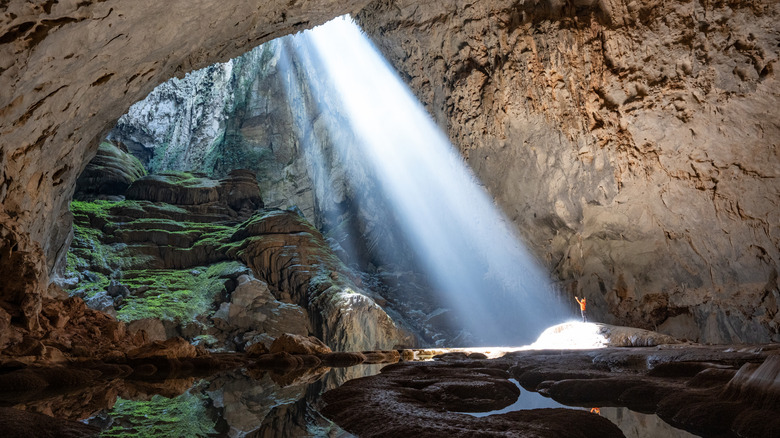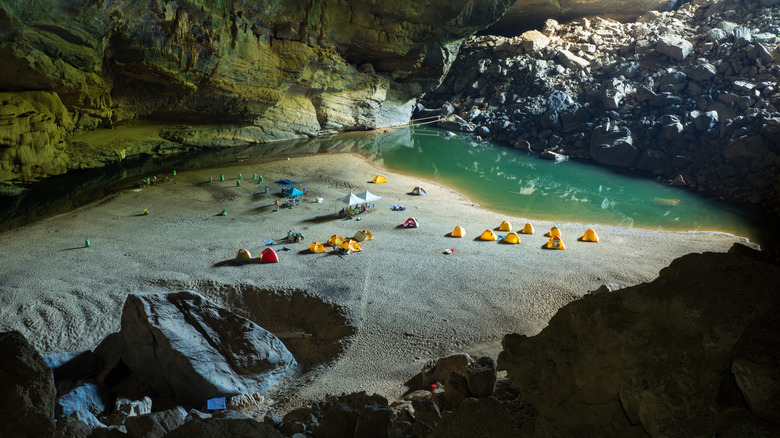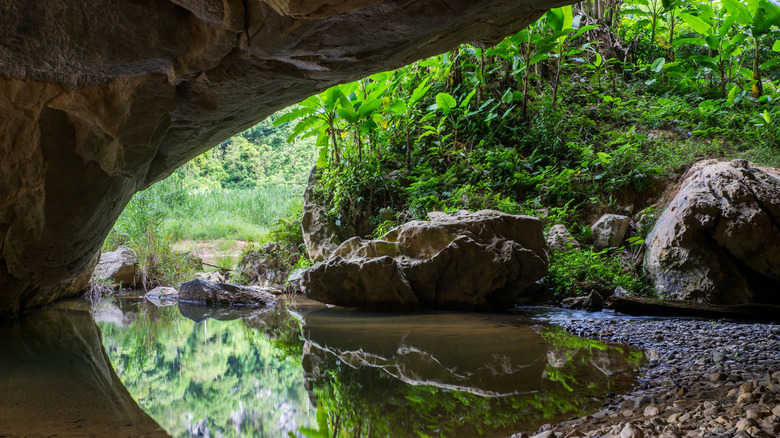The Largest Cave In The World Lies Hidden In Vietnam's Jungle (And It Takes Four Days To Explore)
Imagine the surprise of young lumberjack, Ho Khanh, a native of Vietnam's then-sleepy Phong Nha township, when he saw enormous, ethereal columns of fog billowing out of the ground, like the earth itself exhaling in anger. This is where the fascinating discovery story of Son Doong Cave begins. Khanh came across this eerie sight — mesmerizing to the eyes but terrifying to the soul — in 1990, during a storm. Seventeen years later, a British-Vietnamese caving expedition came to Phong Nha. Khanh shared his experience on that rainy day with the team's leader, but he couldn't relocate the site. However, he journeyed back into the forest on his own and eventually found it. In 2009, when the group returned, he guided them to the elusive entrance. And in 2013, the Guinness World Records recognized what that expedition team already knew: This was the largest natural cave in the world.
Son Doong is part of Phong Nha Ke Bang National Park, a spectacular cave system in central Vietnam, a designated UNESCO World Heritage site, and one of the best lesser-known attractions in Asia. The cave hasn't been explored in its entirety, meaning that it could be much larger than we'll ever know. However, the current stats are unbelievable: Son Doong measures almost 6 miles in length, while certain sections can be up to 650 feet high and 525 feet wide. To put that into perspective, one of its biggest passages, Hope and Vision, is large enough for a Boeing 747 to fly through. Since 2013, it has been possible to explore this alien-like landscape. Visitors can reach the very depths of Son Doong's underground chambers via a four-day trek offered by Oxalis Adventures — the only tour company authorized to run the subterranean expeditions — for a staggering $3,000 per person.
Exploring Son Doong Cave with Oxalis Adventures
On this once-in-a-lifetime expedition, you'll do several underground river crossings. Son Doong (Hang Sơn Đoòng in Vietnamese) roughly translates to "mountain river cave" — a fitting name, as cool rivers flow through its limestone formations. Over almost 3 million years, the Khe Ry and Rao Thuong rivers gradually carved out the very passages you'll visit, enlarging them over time so that now, a city block of skyscrapers could fit inside. Due to its mammoth size and the presence of rivers, clouds have formed, giving Son Doong its own unique climate and weather systems.
On the second and third days, you'll camp at two magnificent dolines, the creatively named Watch Out for Dinosaurs and Garden of Edam. Dolines are natural skylights formed when parts of a cave's ceiling collapse, and they allow for excellent photography opportunities. From 11 a.m. to 1 p.m., at the first doline, you'll witness glorious sunbeams filling up the passage with light (but, unfortunately, you won't see any Jurassic-era sauropods). On the way here, you'll pass the Hope and Vision stalagmite, speculated to be the world's tallest at 262 feet high, along with the photogenic, mushroom-shaped Hand of Dog structure.
At the second doline, you'll find a unique ecosystem that has remained untouched for millions of years, lush with vegetation. Here you'll spot mosses, ferns, a variety of trees, begonias, and other floral species — and on occasion, monkeys, birds, and snakes — in this primeval jungle landscape reminiscent of a scene from "Jumanji." On your last day inside the cave, your final challenge will be to ascend the Great Wall of Vietnam, a 295-foot calcite flowstone overlooking an otherworldly, emerald-green lake. This will be done using a variety of technical caving equipment, and shortly after scaling the wall, you'll reach the exit.
Things to know before your Son Doong Cave expedition
You'll meet your team in the city of Dong Hoi, which is accessible by bus, train, or plane. From Hanoi or Ho Chi Minh City (also known as Saigon), you can catch a domestic flight to Dong Hoi Airport. Meanwhile, from Da Nang, another major city in central Vietnam, comfortable sleeper buses and trains are available. If it's your first time visiting the country, read this guide with crucial details every tourist should know before a trip to Vietnam.
You might be wondering why this trip's price tag is so steep, since Vietnam is one of the cheapest travel destinations in the world. Indeed, $3,000 may seem exorbitant for four days (technically, it's a six-day trip, with the first and last days dedicated to briefing and transporting guests). However, this includes taxes, national park and entrance fees, pick-ups and drop-offs, safety equipment, accommodations, food, and more. As well, for every expedition, porters, chefs, a guide, a cave expert, and other experienced staff accompany the group.
Son Doong can only be visited from the end of January to the end of August, as the weather conditions are dangerous outside of that time. So, ensure that you reserve well in advance — the 2026 tours are already sold out, and 2027 is now open for booking. Each tour has a limit of 10 participants, and a maximum of 1,000 visitors are allowed annually. Oxalis welcomes all adventurers aged 18 to 70 on this expedition; however, participants must be in good physical condition due to the difficulty of the terrain and technical components required. This challenging yet rewarding experience isn't for the faint-hearted: You'll be wading through knee-deep rivers, scrambling over boulders, rope-climbing using ladders, and crossing sandbanks — as the elevation increases from 500 to 2,600 feet.


